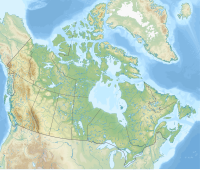Bob Creek Wildland Provincial Park
| Bob Creek Wildland Provincial Park | |
|---|---|
wilderness area)[1] | |
| Location | Municipal District of Ranchland, Alberta, Canada |
| Nearest city | Claresholm |
| Coordinates | 50°00′00″N 114°20′00″W / 50.00000°N 114.33333°W |
| Area | 20,777.69 ha (80.2231 sq mi)[2] |
| Established | 12 May 1999[3] |
| Governing body | Alberta Parks[4] |
Bob Creek Wildland Provincial Park is a
Location
The park is located approximately 50 kilometres (31 mi) west of
Ecology
The park contains the
Geography
The geography of the park is rolling
Climate

The Köppen climate classification of the park is Continental, Subarctic (Dfc) characterized by long, cold, dry winters, and short, cool, moist summers.[14] Using the data from nearby weather stations, Livingstone and Livingstone Gap Auto, for 1991 to 2020, the average daily temperatures exceeds 10 °C (50 °F) only for July and August while average daily temperatures are less than 0 °C (32 °F) for November through March. Livingstone is to the northwest of the park while Livingstone Gap Auto is to the southwest. At Livingstone, the long-run average precipitation from 1991 to 2020 for the wettest month, June, exceeds 110 mm (4.3 in) per month while Livingstone Gap Auto was only about 75 mm (3.0 in) per month. Conversely, the stations receive less than 50 mm (2.0 in) per month from October through March.[15] Strong Chinook winds, which are common during the winter, and low humidity keep the area intermittently snow-free.[7]
Vegetation
South and west-facing slopes and valley bottoms in the park tend to be drier sites and are covered with grasses.
At higher elevations and particularly on north and north-east facing slopes grow
: 5Wildlife

The parks are unique in Alberta as the warm Chinook winds clear the
Carnivores regularly in the park include cougars, coyotes, and wolves. American black bears and grizzly bears frequent the park in the summer as they migrate through and forage for food.[4][9][7]: 20
The park is located within Wildlife Management Units where Alberta Fish and Wildlife staff regularly inventory wildlife populations. Hunting is permitted to manage the level of wildlife obtained through these inventories to maintain a healthy population and environment. As of July 2011[update], the following species can be hunted: black bear, cougar, elk, moose, mule deer, white-tailed deer, and wolves.[7]: 21
Within the park, the Oldman River contains bull trout, cutthroat trout, rainbow trout, and mountain whitefish. White Creek contains cutthroat trout and bull trout while Camp Creek produces a cutthroat trout/rainbow trout hybrid. Bob Creek contains cutthroat trout. The Oldman River and the streams within the park are major destinations for trout fishermen. The river and streams are managed under the Eastern Slopes trout stream regulations and are managed through seasonal closures and restrictive possession limits. The Oldman River fishery is managed under a “catch and release” regulation. Streams are managed with catch and minimum size limits and seasonal closures.[7]: 19
Activities
Backcountry hiking and camping are permitted in the park. In addition, hunting and fishing are allowed when properly licensed. The park has extensive trails for horse back trail riding and off-highway vehicles, defined as snowmobiles and quads. Motorized vehicles must remain of established trails. No off trail use is permitted.[9] Normally, the use of off-highway and highway vehicles are not permitted in Heritage Rangeland like Black Creek; however, legislation was created to allow vehicle use on two trails in Black Creek to access Bob Creek.[7]: 2 Those trails are the Bob Creek Trail and the Camp Creek Trail.[16] The use of off-highway vehicles is controversial.[8]
See also
- List of provincial parks in Alberta
- List of Canadian provincial parks
- Ecology of the Rocky Mountains
References
- ^ UNEP-WCMC (1999). "Protected Area Profile for Bob Creek Wildland Provincial Park from the World Database on Protected Areas". Protected Planet. Retrieved 19 January 2023.
- ^ a b Plan Showing Bob Creek Wildland Provincial Park (PDF) (Map). Alberta Parks. 13 June 2003.
- ^ a b "O.C. 214/99". Orders in Council. Alberta King’s Printer. 12 May 1999.
- ^ a b c d e f "Information & Facilities - Bob Creek Wildland Provincial Park". Alberta Parks. 3 February 2022.
- ^ "O.C. 318/2003". Orders in Council. Alberta King's Printer. 24 June 2003.
- ISBN 978-1-4601-3941-7. Retrieved 17 January 2023.
- ^ ISBN 978-0-7785-9429-1.
- ^ a b "Whaleback". Alberta Wilderness Association. Retrieved 17 February 2022.
- ^ a b c d "Backcountry Guide" (PDF). Alberta Parks. September 2019.
- ^ "Terrestrial Ecodistricts of Canada". Government of Canada.
- ISBN 978-0-660-24501-0. Catalogue no. 12-607-X.
- ^ Noss, Reed. "Northern Rockies Conifer Forests". OneEarth.org.
- ^ "Alberta Topographic Map". Topographic-Map.com. Retrieved 28 March 2023.
- ^ Atlas of Canada: Climatic Regions (PDF) (Map). Government of Canada. Archived (PDF) from the original on 15 March 2023. Retrieved 23 March 2023.
- ^ "Climate Normals for Alberta: (Livingstone and Livingstone Gap Auto)". Government of Alberta. 2020. Retrieved 23 March 2023.
- ^ Black Creek Heritage Rangeland Trails Act, SA 2004, c. B-2.5, Sch. 1(c)
External links
- Wildland Provincial Parks on YouTube



